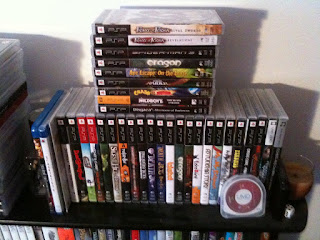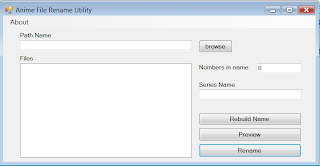High Scores in games...
Looking back over my game collection, this is one thing that has gradually been removed from games as time has progressed. I think a large part of this is the gamer points and trophy system that the new consoles have provided players. Now it is not so much about high scores, it is about number of gamer points and trophies that you have collected. We have turned into a society of completion gamers, trying to achieve a 100% goal everytime, instead of the society of competitive gamers that we once were, striving for a higher and higher score.
I believe the root cause of this is that the arcade environment is no longer a common meeting place for gamers, where people can come together in a dark, slightly smelly room, and compete head to head for a coveted place on a high score list. To see ones initials displayed in technicolor glory for the world to see on a publicly displayed system was once a grand achievement.
On one hand I think it could be argued that this has improved the design of games and has taught us that not every game needs to be about competition against others, that co-op missions and single player campaigns can provide better entertainment value. However, with the number of multiplayer deathmatch shooter games out there, Call of Duty Modern Warfare 2 being the most recent in the long chain of these to come to market, that the level of competition is still there. I noticed that even though the game had been out for only 3 weeks, there were those that had been playing the multiplayer aspect of that game for a total play time of 15 days. That would require you to play for almost every waking minute given an eight hour sleeping cycle each night.
The thing is, games like CoD MW2 still have a point system. Characters have a kill count and a death count. Also, CoD has added a leveling system to multiplayer that allow people to rank against each other. Thus I argue that games like these still require scoring, even if the score is no longer arbitrary. Also by providing these scores available to everyone who owns the game, we still see the display of personal prowess and skill to the greater public. It could almost be said that non-arbitrary point systems, such as experience or leveling has improved game design in a competitive sense.
I think there is still a place for arbitrary scoring though in the game space, the place I see this is with social networking games, or games that provide interfaces for score display to communities such as Facebook and Twitter. Games such as Canabalt and Bejeweled can be used as good examples of this. Bejeweled displaying scores of those in Bejeweled Blitz group being able to compare scores directly on Facebook, or Canabalt, with its option to post your high score (or low score if the case may be) to Twitter directly after dying.
Being that for the most part, I am a single player game type of gamer, I find myself being left out of these situations for the most part. The competition is not a driving factor for me, and as a result I tend to measure completion of games by their storylines. On the other hand, games such as racing games and platformers, I would actually appreciate a score. Regardless of the fact that I am not playing against anyone, I think that by having a score, I am in essence playing against myself. That competition keeps a game more enjoyable for longer. While playing Guitar Hero, the only reason I kept playing that game was because I could physically see myself getting better by the amount of points I would receive for a given song or the percentage I could complete before losing decreasing as I learned the patterns. The same holds true for my self admitting addiction to Dance Dance Revolution when I worked in an arcade for a while. By breaking my previous high score, I am in essence beating a game again that although it has not changed as far as story line or character development, has become more challenging.
Another method that could be said scores game progress is collectables. In platformers especially this holds true. Games such as the Sly Cooper series, or Ratchet and Clank, Jax and Daxter, even Assassin's Creed, has a system in place for tracking your completion progress throughout the game via collectables. Any game that says you have collected 50/100, whether it be gems, flags, bobble heads, what have you, is indicating a score. This score is the percentage of the game you have completed. Granted, with the new trophy system/achievement system on the modern consoles, these tend to correlate with awards for 100% collection in modern games, but the in game mechanic itself provides the challenge that a player would normally associate with achieving a higher score.
Overall, I must say that I believe that scores in games are not gone, they have just evolved. We may have become a society of completionists, and in some cases non-completionists when it comes to not having the patience to collect everything in a game, but is this really a bad thing? I would argue that perhaps not. The high score in a game may only be 100%, but 100% still feels good.
I believe the root cause of this is that the arcade environment is no longer a common meeting place for gamers, where people can come together in a dark, slightly smelly room, and compete head to head for a coveted place on a high score list. To see ones initials displayed in technicolor glory for the world to see on a publicly displayed system was once a grand achievement.
On one hand I think it could be argued that this has improved the design of games and has taught us that not every game needs to be about competition against others, that co-op missions and single player campaigns can provide better entertainment value. However, with the number of multiplayer deathmatch shooter games out there, Call of Duty Modern Warfare 2 being the most recent in the long chain of these to come to market, that the level of competition is still there. I noticed that even though the game had been out for only 3 weeks, there were those that had been playing the multiplayer aspect of that game for a total play time of 15 days. That would require you to play for almost every waking minute given an eight hour sleeping cycle each night.
The thing is, games like CoD MW2 still have a point system. Characters have a kill count and a death count. Also, CoD has added a leveling system to multiplayer that allow people to rank against each other. Thus I argue that games like these still require scoring, even if the score is no longer arbitrary. Also by providing these scores available to everyone who owns the game, we still see the display of personal prowess and skill to the greater public. It could almost be said that non-arbitrary point systems, such as experience or leveling has improved game design in a competitive sense.
I think there is still a place for arbitrary scoring though in the game space, the place I see this is with social networking games, or games that provide interfaces for score display to communities such as Facebook and Twitter. Games such as Canabalt and Bejeweled can be used as good examples of this. Bejeweled displaying scores of those in Bejeweled Blitz group being able to compare scores directly on Facebook, or Canabalt, with its option to post your high score (or low score if the case may be) to Twitter directly after dying.
Being that for the most part, I am a single player game type of gamer, I find myself being left out of these situations for the most part. The competition is not a driving factor for me, and as a result I tend to measure completion of games by their storylines. On the other hand, games such as racing games and platformers, I would actually appreciate a score. Regardless of the fact that I am not playing against anyone, I think that by having a score, I am in essence playing against myself. That competition keeps a game more enjoyable for longer. While playing Guitar Hero, the only reason I kept playing that game was because I could physically see myself getting better by the amount of points I would receive for a given song or the percentage I could complete before losing decreasing as I learned the patterns. The same holds true for my self admitting addiction to Dance Dance Revolution when I worked in an arcade for a while. By breaking my previous high score, I am in essence beating a game again that although it has not changed as far as story line or character development, has become more challenging.
Another method that could be said scores game progress is collectables. In platformers especially this holds true. Games such as the Sly Cooper series, or Ratchet and Clank, Jax and Daxter, even Assassin's Creed, has a system in place for tracking your completion progress throughout the game via collectables. Any game that says you have collected 50/100
Overall, I must say that I believe that scores in games are not gone, they have just evolved. We may have become a society of completionists, and in some cases non-completionists when it comes to not having the patience to collect everything in a game, but is this really a bad thing? I would argue that perhaps not. The high score in a game may only be 100%, but 100% still feels good.











